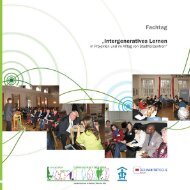Rundbrief 1 - Verband für sozial-kulturelle Arbeit eV
Rundbrief 1 - Verband für sozial-kulturelle Arbeit eV
Rundbrief 1 - Verband für sozial-kulturelle Arbeit eV
Sie wollen auch ein ePaper? Erhöhen Sie die Reichweite Ihrer Titel.
YUMPU macht aus Druck-PDFs automatisch weboptimierte ePaper, die Google liebt.
fragmentiert und im Fluss. Um stark und verjüngt<br />
zu werden, brauchen die Gemeinwesen eine Form<br />
von Gemeinwesenaufbau, der die unterschiedlichen<br />
Interessen im Gemeinwesen überbrücken kann und<br />
eine Plattform für seine Mitglieder bietet, sich in permanenter<br />
Aushandlung mit dem Ziel strategischer<br />
Solidarität zu engagieren. Mit seinem geschichtlich<br />
verbürgten Erfolg bei der Brückenbildung über gesellschaftliche<br />
Unterschiede hinweg und bei der Generierung<br />
<strong>sozial</strong>en Kapitals, spielt das Settlement-Haus<br />
eine wichtige Rolle im Gemeinwesenaufbau unter<br />
den Bedingungen der Globalisierung. Die Wiederbelebung<br />
des Settlement-Hauses ist eine Verpflichtung<br />
auch für die Sozialarbeits-Profession, eine Profession,<br />
die ihre Wurzeln in der Settlement-Bewegung und<br />
eine Aufgabe im Gemeinwesenaufbau hat.<br />
Übersetzt von Herbert Scherer<br />
Abdruck mit freundlicher Genehmigung von Haworth Press<br />
Inc.<br />
Das Original des Artikels ist unter dem Titel<br />
„Bridging the Fragmented Community: Revitalizing<br />
Settlement Houses in the Global Era“ im Journal of<br />
Community Practice, Vol. 12(1/2) 2004 erschienen<br />
© des englischen Originals Haworth Document Delivery<br />
Service: 1-800-HAWORTH.<br />
Der Originaltext kann hier (gegen Gebühr) bezogen<br />
werden.<br />
E-mail address: docdelivery@haworthpress.com<br />
Konditionen auf der Website von Haworth Press: http:<br />
//www.haworthpress.com/web/COM<br />
Abel, E. K. (1979). Toynbee Hall, 1884-1914. Social Service Review, 53(4), 606-632.<br />
Abramovitz, M. (1998). Social work and social reform: An arena of struggle. Social Work, 43(6), 512-526.<br />
Addams, J. (1999). Twenty Years at Hull House. Boston, MA: Bedford/St. Martin’s.<br />
Albrow, M. (1993). Globalization. In W. Outhwaite & T. Bottomore (Eds.), The Blackwell Dictionary of Twentieth-Century Social Thought (pp. 248-249). England: Oxford: Blackwell.<br />
Anderson, B. (1991). Imagined Communities (2nd ed.). London and New York: Verso.<br />
Andrews, J. (1997). Helen Hall and the Settlement House Movement’s response to unemployment: Reaching out to the community. Journal of Community Practice, 4(2), 65-75.<br />
Armitage, A. (1991). Social Welfare in Canada: Ideals, Realities, and Future Paths (2nd ed.). Toronto: McCelland & Stewart.<br />
Berman-Rossi, T.,&Miller, I. (1994). African-Americans and the settlements during the late nineteenth and early twentieth centuries. Social Work with Groups, 17(3), 7-95.<br />
Bottomore, T. (1979). Political Sociology. London, UK: Hutchinson.<br />
Carson, M. (1990). Settlement Folk: Social Thought and the American Settlement Movement, 1885-1930. Chicago, IL: University of Chicago Press.<br />
Chesler, E. (1996). “Back to the Future”: Reviving the settlement house as neighborhood social service center. In J. Vitullo-Martin (Ed.), Breaking Away: The Future of Cities (pp. 121-134).<br />
New York, NY: The Twentieth Century Fund Press.<br />
Chow, N. (1980). Social Welfare in Hong Kong: Development and Policies (in Chinese). Hong Kong: Hong Kong University Publisher.<br />
Cox, E. O. (2001). Community practice issues in the 21st Century: Questions and challenges for empowerment-oriented practitioners. Journal of Community Practice, 9(1), 37-55.<br />
Drover, G. (2000). Redefining social citizenship in a global era. Canadian Social Work (Social Work and Globalization: Special Issue), 2(1), 29-49.<br />
Epstein, L. (1999). The culture of social work. In A. S. Chambon, A. Irving, & L. Epstein (Eds.), Reading Foucault for Social Work (1 ed., pp. 3-26). New York: Columbia University Press.<br />
Etzioni, A. (1993). The Spirit of Community: Rights, Responsibilities, and the Communitarian Agenda. New York: Crown Publishers.<br />
Fabricant, M. B.,& Fisher, R. (2002). Settlement Houses Under Siege: The Struggle to Sustain Community Organization in New York City. New York, NY: Columbia University Press.<br />
Ferguson, R. F., & Dickens, W. T. (1999). Introduction. In R. F. Ferguson, & W. T. Dickens (Eds.), Urban Problems and Community Development (pp. 1-31). Washington, DC: Brookings<br />
Institution Press.<br />
Fisher, R., & Fabricant, M. B. (2002). From Henry Street to contracted services: Financing the settlement house. Journal of Sociology and Social Welfare, XXIX(3), 2-27.<br />
Fisher, R., & Kling, J. (1997). Community organization, new social movement theory and the condition of postmodernity. In D. J. Tucker, C. Garvin,&R. Sarri (Eds.), Integrating Knowledge<br />
and Practice: The Case of Social Work and Social Science (pp. 105-115). Westport, CT: Praeger Publisher.<br />
Giddens, A. (1998). The Third Way: The Renewal of Social Democracy. Cambridge: Polity<br />
Giddens, A. (1994). Beyond Left and Right: The Future of Radical Politics. Cambridge, UK: Polity Press.<br />
Giddens, A. (1998). The Third Way: The Renewal of Social Democracy. Cambridge: Polity Press.<br />
Giddens, A.,& Dahrendorf, R. (Winter, 2001). September 11. LSE Magazine, 13, 4-6. 66 JOURNAL OF COMMUNITY PRACTICE<br />
Glyn, A. (1998). Egalitarianism in a global economy. Boston Review. Retrieved on November 22, 2003 at http://www.bostonreview.net/BR22.6/glyn.html.<br />
Hall, J. A. (1995). In search of civil society. In J. A. Hall (Ed.), Civil Society: Theory, History, Comparison (pp. 1-31). Cambridge, UK: Polity Press.<br />
Hasson, S., & Ley, D. (1994). Neighbourhood Organizations and the Welfare State. Toronto, On.: University of Toronto Press.<br />
Hayes, K. S. (1998). The one hundred-year debate: Social reform versus individual treatment. Social Work, 43(6), 501-509.<br />
Haynes, D. T., & White, B. W. (1999). Will the „real“ social work please stand up A call to stand for professional unity. Social Work, 44(4), 385-391.<br />
Hillman, A. (1960a). Neighbourhood Centres Today: Action Program for a Rapidly Changing World. New York: National Federation of Settlements and Neighbourhood Centres.<br />
Hillman, A. (1960b). Neighbourhood Centres Today: Action Program for a Rapidly Changing World. New York: National Federation of Settlements and Neighbourhood Centres.<br />
Hiroto, J. M., Brown, P.,&Martin, N. (1997). Building Community: The Tradition and Promise of Settlement Houses. New York, NY: United Neighborhood Houses of New York.<br />
Husock, H. (1993). Bring back the settlement house: Settlements see poor people as citizens, not clients. Public Welfare, 51(4), 16-25.<br />
Ife, J. (2000). Localized needs and a globalized economy: Bridging the gap with social work practice. Canadian Social Work (Social Work and Globalization: Special Issue), 2(1), 50-64.<br />
Irving, A., Parsons, H., & Bellamy, D. (Eds.) (1995). Neighbours: Three Social Settlements in Downtown Toronto. Toronto: Canadian Scholars’ Press.<br />
Johnson, A. K. (1998). The revitalization of community practice: Characteristics, competencies, and curricula for community-based practices. Journal of Community Practice, 5(3), 37-62.<br />
Kaul, M. L. (1988). Developing neighbourhood organizations as social structures for peace. International Social Work, 31, 45-52.<br />
Klein, P. (1968). From Philanthropy to Social Welfare. San Francisco, CA: Jossey-Bass.<br />
Koerin, B. (2003). The settlement house tradition: Current trends and future concern. Journal of Sociology and Social Welfare, XXX(2), 53-68.<br />
Lasch, C. (Ed.) (1965). The Social Thought of Jane Addams. Indianapolis, IN: Bobbs-Merrill Co.<br />
Lasch-Quinn, E. (1993). Black Neighbors: Race and the Limits of Reform in the American Settlement House Movement, 1890-1945. Chapel Hill, NC: The University of North Carolina<br />
Press.<br />
Leonard, P. (1997). Postmodern Welfare. London: SAGE.<br />
Miu Chung Yan 67 Lissak, R. S. (1989). Pluralism & Progressives: Hull House and the New Immigrants, 1890-1919. Chicago, IL: University of Chicago Press.<br />
McQuaig, L. (1999). The Cult of Impotence: Selling the Myth of Powerlessness in the Global Economy. Toronto, ON: Penguin.<br />
Midgley, J. (2000). Globalization, capitalism, and social welfare: A social development perspective. Canadian Social Work (Social Work and Globalization: Special Issue), 2(1), 13-28.<br />
Mishra, R. (1999). After globalization: Social policy in an open economy. Canadian Review of Social Policy (43), 13-28.<br />
Mizrahi, T., & Rosenthal, B. (1998). „A whole lot of organizing going on”: The status and needs of organizers in community-based organizations. Journal of Community Practice, 5(4), 1-24.<br />
Perez-Diaz, V. (1995). The possibility of civil society: Traditions, character, and challenges. In J. Hall (Ed.), Civil Society: Theory, History, Comparison (pp. 80-109). Cambridge, UK: Polity<br />
Press.<br />
Putnam, R. (2000). Bowling Alone: The Collapse and Revival of American Community. New York, NY: A Touchstone Book.<br />
Ramey, J. H. (1992). Group work practice in neighborhood centers today. The Haworth Press, Inc. 193-206.<br />
Reinders, R. C. (1982). Toynbee Hall and the American settlement movement. Social Service Review, 56(1), 39-54.<br />
Rivera, F. G., & Erlich, J. L. (1981). Neo-Gemeinschaft minority communities: Implications for community organization in the United States. Community Development Journal, 16(3), 189-<br />
200.<br />
Rose, N. (1999). Powers of Freedom: Reframing Political Thought. Cambridge, UK: Cambridge University Press.<br />
Shore, C. (1993). Community. In W. Outhwaite,&T. Bottomore (Eds.), The Blackwell Dictionary of Twentieth-Century Social Thought (pp. 98-99). England: Oxford: Blackwell.<br />
Sites, W. (1998). Communitarian theory and community development in the United States. Community Development Journal, 33(1), 57-65.<br />
Smith, G. (1996). Ties, nets, and an elastic bund: Community in the postmodern city. Community Development Journal, 31(3), 250-259.<br />
Specht, H.,&Courtney, M. E. (1994). Unfaithful Angels: How Social Work Has Abandoned Its Mission (1 ed.). New York: The Free Press.<br />
Trolander, J. A. (1987). Professionalism and Social Change. New York: Columbia University Press.<br />
Weil, M. (1997). Introduction: Models of community practice in action. Journal of Community Practice, 4(1), 1-9.<br />
Wharf, B. (1998). Local Governance. In B. Wharf, & B. McKenzie (Eds.), Connecting Policy to Practice in the Human Services. Toronto, ON: Oxford University Press. 68 JOURNAL OF<br />
COMMUNITY PRACTICE<br />
Wharf, B., & Clague, M. (1997). Lessons and legacies. In B. Wharf, & M. Clague (Eds.), Community Organizing: Canadian Experiences (pp. 302-325). Toronto: Oxford University Press.<br />
Yan, M. C. (1998). Towards a complete view of the social policy process: An integration of policy formulation and implementation. Canadian Review of Social Policy, Winter 1988(42), 37-53.<br />
Yan, M. C. (2002a). Recapturing the history of Settlement House Movement: Its philosophy, service model, and implications in China’s development of community- based centre services.<br />
Asian Pacifi c Journal of Social Work, 12(1), 21-40.<br />
Yan, M. C. (2002b). Reclaiming the social of social group work: An experience of a community center in Hong Kong. Social Work with Groups, 12(1), 21-40. Miu Chung Yan 69<br />
12












